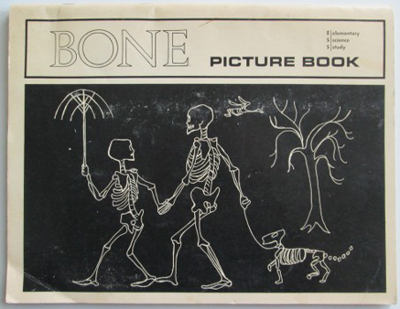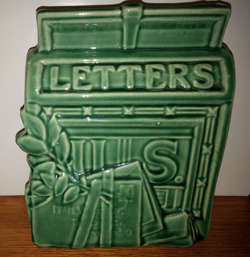 |
|
|||
 |
 |
|||
RINKER ON COLLECTIBLES — Column #1415 Copyright © Harry Rinker, LLC 2014
Questions
and Answers QUESTION: I own a copy of the “Bone Picture Book,” published by McGraw-Hill in 1968. Before listing it on eBay, I tried to research its value. I found no information on www.abebooks.com, www.amazon.com, www.ebay.com, and www.worthpoint.com. I am considering an opening bid request of $12.00 but concerned the request is too low. What is your opinion? – SK, Richmond, CA
ANSWER: The pictures of the title page, copyright page, preface, and several content pages attached to your email contained the clues to answer your question. Your “Bone Picture Book” was a school text for students doing “Elementary Science Study.” The secondary market for elementary school, middle school, high school, and college and university textbooks is minimal to non-existent. While college and university students attempt to save money by buying used books or recover money by selling their textbooks, college and university textbook publishers constantly issue new editions, with only minor changes, to discourage these practices. The “picture book” nature of your book is a plus. The “elementary” level of the material is a negative. An opening bid of $12.00 is not likely to attract any bidders. Open it at $1.00 and let the market decide its value. Do not be surprised if the final bid is under $5.00. QUESTION: I own a pewter kangaroo wearing boxing gloves. The body appears to be made from computer chips. The base is marked “Honeywell” on the bottom. I believe the kangaroo was used as the Honeywell logo in the 1950s. One of the arms is broken off. What is its value? – M, Lancaster County, PA ANSWER: In 1955, Honeywell entered the computer field with Raytheon Corporation through a joint venture called Datamatic Corporation. In 1963, Honeywell introduced the Honeywell 200, designed to compete with IBM’s 1401. Honeywell assumed the leadership for GE’s Multic Operating system in 1970. Groupe Bull acquired Honeywell’s computer division in 1989. The figurine was made for Honeywell by Hudson pewter. It is a small replica of the boxing kangaroo used in Honeywell advertising. Honeywell presented the paperweight to Multica developers at an appreciation dinner in Boston in 1973. The kangaroo measures 3 inches long, 1 1/2 inches deep, and 4 inches tall. Honeywell ran a series of full print advertisements from 1964 to 1978 featuring various animal sculptures made by Boston artists using capacitors, computer chips, diodes, resistors, and other electrical parts. In addition to the kangaroo, a beaver, bison, bull, dog, dragon, eagle, fish, fox, frog, gazelle, grasshopper, owl, Noah’s ark with animals, pterodactyl, roadrunner, and tiger were featured in the advertisements. WorthPoint.com contains a March 27, 2013, listing for a boxing kangaroo promotional paperweight that sold for $34.99 at Channel Online Auction. A week earlier Channel Online Auction sold another example for $29.99. eBay contains a number of listings for print advertising featuring the kangaroo. Your kangaroo’s broken arm impacts its secondary market value. Not repaired, it is worth under $10.00.
ANSWER: In April 1910, Nelson McCoy, his father J. W. McCoy, and a group of investors established the Nelson McCoy Sanitary and Stoneware Company, located in Roseville, Ohio. In 1918, McCoy joined with 11 other pottery/stoneware manufacturers to create the American Clay Products Company. When an order for a product was received, the ACPC directed it to one of the 11 companies. Wares produced by the companies were not marked. When the ACPC dissolved in January 1926, its members, including McCoy, resumed as independent manufacturers. As the 1920s ended, the Nelson McCoy Sanitary and Stoneware Company dropped the “and” from its name. It also began marking its pieces. The company became the Nelson McCoy Pottery Company in 1933. When the Mt. Clemens Pottery Co. acquired the Nelson McCoy Pottery Company in 1967, Nelson McCoy, Jr., son of the founder, continued as president. In 1974, Lancaster Colony Corporation became the new owner. When Designer Accents of New Jersey acquired the Nelson McCoy Pottery Company in 1985, it consolidated the production of all its pottery operations at McCoy. The pottery closed in late 1990. A 1991 fire destroyed part of the factory and the offices. Designer Accents filed two trademark patents to protect the McCoy trademark, the first in 1989 and the second in 1998. Designer Accents abandoned its application in July 2000. During the period, Roger Jensen of Rockwood, Tennessee, applied for a McCoy trademark. His application was canceled in May 1999. In October, 1999, Rosella Martin of Century Florida applied for a “McCoy” trademark. Her application was abandoned in May 2001. Reproductions and fakes are a major problem in the secondary resale market. See the following URLs: http://www.mccoypotterycollectorssociety.org/fakes5.htm and http://www.realorrepro.com/article/Fakes-and-reproductions-marked-McCoy. The www.realorrepro.com site contains information on a remodeled reproduction of your McCoy mailbox wall pocket planter. The period McCoy mailbox wall pocket planter and the reproduction are marked “McCoy USA.” The period wall pocket planter measures 6 3/4 inches or more in height. The reproduction measures between 6 1/4 and 6 1/2 inches high. McCoy introduced wall pocket planters in the early 1940s. A sales listing on www.lins-antiques.com for an identical McCoy mailbox wall pocket planter has an asking price of $135.00. The seller notes the mailbox wall pocket planter was only made in 1951. A second example at http://www.tias.com/8731/PictPage/3923889786.html lists at $65.00. I also found another sales listing for a “pink” example. The example in the www.realorrepro.com article was yellow. I suggest consulting Craig Nelson’s “McCoy Wall Pockets & Decorations: Identification & Values,” published by Collector Books in 2004, to discover what colors were used during the initial production period. After reviewing asking and sell through prices on a variety of internet sites for McCoy wall pocket planters, your McCoy mailbox wall pocket planter has a value between $60.00 and $80.00. QUESTION: I purchased a set of Dale Earnhardt cards issued by Mom and Pop’s Country Ham in 1991. I expected them to increase significantly in value. Today, an individual card retails for $2.00 or less. How do you account for this? – W, Bristol, TN ANSWER: Mom ‘n’ Pop’s Country Ham, located in Claremont, North Carolina, began in 1972 as a firm to provide cured hams to restaurants. Currently, the firm cures over 10,000 hams per week. Mom ‘n’ Pop was one of Dale Earnhardt’s sponsors. In 1991, Traks Racing Cards issued a six-card set featuring Dale Earnhardt and labeled on the bottom of each card with “Mom ‘n’ Pops Country Biscuits.” Cards from the Mom ‘n’ Pop 1991 set appear regularly for sale on eBay. Ungraded cards sell in the $2.00 to $3.00 range. An eBay seller has a PSA 9 Mint No. 4 card listed for a Buy It Now price of $19.95. I also found on eBay a full set of cards offered for $8.00 and a factory sealed bag set for $4.99. Instead of the card set, you should have acquired the 1991 NASCAR Dale Earnhardt Sr. Mom ‘n’ Pop Championship ham bag. An eBay seller has one listed for $39.95. The low value of this card set is easily explained. First, NASCAR card collecting was hot in the late 1980s and early 1990s. Collectors bought and hoarded large numbers of card sets. Second, as the NASCAR cards entered the secondary market in the mid- to late 1990s, the market became flooded. Rather than realizing the speculative price increase buyers had hoped for, the secondary market value collapsed. Finally, supply continues to exceed demand. There are no signs of this reversing in the near or long-term future.Harry L. Rinker welcomes questions from readers about
collectibles, those mass-produced items from the twentieth and twenty-first centuries.
Selected letters will be answered in this column.
Harry cannot provide personal answers.
Photos and other material submitted cannot be
returned.
Send your questions to: Rinker on Collectibles, 5955 Mill
Point Court SE, Kentwood, MI 49512.
You also can e-mail your questions to
harrylrinker@aol.com.
Only e-mails containing a full name and mailing address
will be considered.
You can listen
and participate in
WHATCHA GOT?, Harry’s
antiques and collectibles radio call-in show, on Sunday mornings between 8:00 AM
and 10:00 AM Eastern Time.
If you
cannot find it on a station in your area,
WHATCHA GOT?
streams live on the Internet at www.gcnlive.com.
SELL, KEEP OR TOSS?: HOW TO DOWNSIZE A HOME,
SETTLE AN ESTATE, AND APPRAISE PERSONAL PROPERTY
(House of Collectibles, an imprint of Random House Information Group, $17.99),
Harry’s latest book, is available at your favorite bookstore and via
www.harryrinker.com.
|
||||

 QUESTION: I own a Kelly green glazed, mailbox-shaped wall pocket planter. It is marked “McCoy USA” on the bottom. What is its value? – ST, Reading, PA, Email Question
QUESTION: I own a Kelly green glazed, mailbox-shaped wall pocket planter. It is marked “McCoy USA” on the bottom. What is its value? – ST, Reading, PA, Email Question